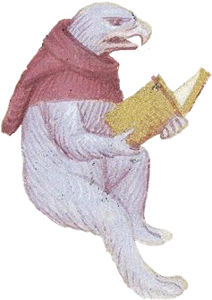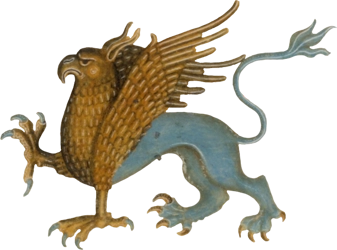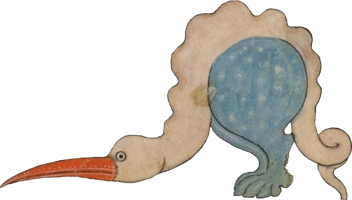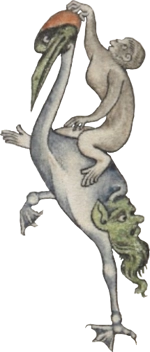Arteful Avian Adventures
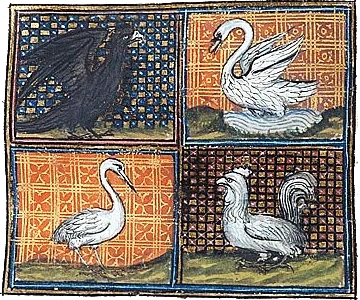
Arteful Avian Adventures The Folklore of Birds
Paraphrased excerpts from the book by Laura C. Martin
“It is not only fine feathers that make fine birds.” — Aesop
The Folklore of Birds is a celebration of the beauty and glory of the birds, their histories and personalities, and their influence on the world of man. In exploring the nature and wonder of birds, and in becoming more intimately familiar with them, it is my hope that we will develop a sensitivity and a renewed appreciation of these fellow creatures … The song of the bird is the song of hope, a fervent prayer that man will learn to live in harmony with all the inhabitants of the earth. Centuries from now, when the world of man has changed and we are perhaps still struggling to communicate with one another, the voice of the bird will still sing true, a universal language uniting us in a common song. — L. C. Martin
A
ALBATROSS: Also known as the gooneybird or mollyhawk due to their graceless meeting of feathers and water with awkward landings. Despite it being thought bad luck to kill one of these birds, natives of many oceanic islands regularly ate meat from these birds as did whalers and sealers that visited. Samuel Taylor Coleridge made them infamous with his poem The Rime of the Ancient Mariner. Even today to speak of an albatross around one’s neck indicates an unwieldy and heavy problem. They were also thought to bring storms and bad weather with high gales. An old poem called Lalla Rookh describes the albatross laying it’s eggs in a floating nest.
B
BLACKBIRD: The old nursery rhyme “sing a song of sixpence, / a pocketful of rye, / four and twenty blackbirds, / baked in a pie” is based on truth as members of royalty (who used them for amusements) as well as peasants ate the blackbird many centuries ago. General symbolism connects the bird to everlasting life and the struggle between the body and soul. Northern Louisiana Indians tell of how the color came to the red-winged blackbird. The marshes were set afire by a wicked man. To get help, a small blackbird rose up from the flames and flew off to get aid. The man was so filled with ire he threw a shell at the bird causing its wing to bleed.
C
CRANE: An ancient belief about migrating Cranes is that they swallow a stone before they leave. This stone acts as a ballast, keeping the cranes on course even in heavy winds. The stone regurgitated was thought to be a touchstone for gold. The word pedigree is derived from pied de grue — French for “foot of the crane” — taken from the stance they were known from that was later used in English heraldry — a stone held in one claw — a symbol of vigilance.
CROW: A character in the Asinaria by Plautus in the third century B.C. says that “The Woodpecker and the Crow on my right, the Raven on my left are persuading me to do it.” — An old folk saying claims that seeing crows fly over in various numbers meant certain things — “One for sorrow, two for mirth, three for a wedding, four for a birth.” The soul of Arthur of the Round Table is said to survive in the form of a crow. Crow’s Feet are those fine lines and network of wrinkles found near the eyes of older folks.
Her locks as white as snow
Once shamed the swarthy crow;
By-and-by
That fowl’s avenging sprite
Set his cruel foot for spite, near her eye.
D
DOVE: Often shown as symbolizing the descending Holy Spirit in xtian works. In Malory’s Morte d’ Arthur, a Dove appears on the Holy Grail as a symbol of purity and piety of the castle. European superstition has it that if a young girl hears the first call of the dove in the Spring she must take nine steps forward and then nine steps back and then remove her shoe — in it will be the hair of the man she is to marry.
E
EAGLE: Messengers to the Greek God Zeus, to speak of the Eagles of Rome was to speak of the might of the Roman army. The golden Eagle holds special significance to the Plains Indians as it is thought to be the very personification of bravery. Aztec Indian migration ended when leaders saw a portent sign from their Gods — an eagle perched on a prickly-pear cactus, strangling a serpent. And the feathers were thought of ways of communicating with the spirits. William Blake wrote - “The Eagle never lost so much time as when he submitted to learn of the crow”
F
FALCON: Referring to the shape of the of the bird’s claws, this bird draws it’s name from the Latin falx, meaning sickle, they were known to be sacred to Apollo. Falconer’s jargon has many words that are foreign to us today; bowse — meaning to drink, feak — wiping the beak after eating, warble — stretching the wings. Even Shakespeare makes mention of these Peregrines in that Scottish play re: Duncan’s murder:
On Tuesday last,
A falcon, towering her pride of place,
Was by a mousing owl hawk’d at and killed.
G
GOOSE: In many cultures Geese have oft been thought of as laying eggs that represent or become the sun, from this Brahma, the breath of life was born which was why an English proverb remonstrated “Kill not the goose that lays the golden eggs.” The character known to us as Mother Goose comes down to us in the form and guise of an early Queen of France, the mother of Charlemagne, Bertha Goosefoot (or Big-foot as recent descendants have noted) known also to us as Dame Holda in her Winter Court aspect.
Old Mother Goose, when she wanted to wander,
Would ride through the air on a very fine gander.
GULL: Despite the popularity of the sweet tale of Jonathon Livingston by Richard Bach there is no such thing as a Sea Gull per se — that is a catch all term that designates many types of gulls. The name itself is taken from the Welsh Gwylan which means wailing. The old Anglo Saxon name was mew which was a reference to the mewing cry they made.
H
HAWK: The name of the Hawk is taken from the Teutonic root hab meaning to seize or take hold. Icelandic lore gives that a hawk’s tongue held beneath your own will give one to understand the language of the birds. Pomo Indians of California tell of how the world was in darkness and due to the efforts of the coyote and the hawk working in tandem with huge stalks of bulrushes and pieces of flint they created the sun to give light and warmth.
K
KESTREL: Also known as the Sparrow Hawk, the Kestrel takes its name from the Latin word crepitare which means to rattle or crackle — this describes the call made by the kestrel. The Old World name for the Kestrel is the WindHover due to their effect of hovering like a helicopter rather than having the swooping and diving actions as other birds of prey.
KINGFISHER: The European Kingfisher is sometimes called a Halcyon (she being the daughter of the God of the Wind in Greek Myth, Aeolus and wife of Ceyx) After Ceyx was tragically drowned, she drowned herself in her grief and the Gods took pity upon them both and turned them into Kingfishers. Zeus declared that in their honor for seven days before and seven days after the winds should not blow at Winter Solstice which is why they have been known ever after as halcyon days.
L
LARK: The Scottish name for the Lark is the Laverock — in some areas ‘going to look for a lark’s nest” means the same thing as ‘going to see a man about a dog’ or ‘answering a call of nature.’ Their eloquent song has inspired many poets, musicians and artists — the most beautiful tribute coming from Percy Bysshe Shelly in his poem, To A Skylark:
Hail to thee, blithe spirit!
Bird thou never wert,
That from heaven or near it,
Pourest thy full heart
In profuse strains of unpremeditated art.
LOON: The strange, spooky laughing cry that loons make comes from their being startled and alarmed - this same cry give rise to the phrase crazy as a loon. The common name for this bird comes from the Scandinavian for diving bird as they are known to be excellent divers — able to dive to depths of 240 feet and more and stay submerged for up to fifteen minutes. Legends such as these in many cultures led many to believe that the loon was capable of great magic.
M
MAGPIE: The following poem tells the future of one who happens to see a flock of magpies - gauging by the number flying overhead (as with the crows) do you determine the fate of what is to be.
One for sorrow, two for mirth,
Three for a wedding, four for a birth,
Five for silver, six for gold,
Seven for a secret not to be told
Eight for heaven, nine for hell
And ten for the devil’s own sel’.
O
OWL: Symbols of learning and wisdom as well as being associated as a mascot to Athena while figuring prominently in art and myth for centuries as harbingers of doom and evil. Owls also were known for playing the traditional role of psychopomp, the Owl has long been dreaded more than any other bird. Closely associated with another deity, Lilith, She is usually depicted with wings and talons, even her very name in the authorized version of the bible translates as ‘screech owl’.
R
RAVEN: Considered a trickster character in many parts of the world, the Raven, being at once creator and destroyer, giver and negator has a wealth and dearth of myth and folklore that has sprung up around it. A pair of ravens was said to have guided Alexander the Great across the desert - stories such as these have only added to their use in European tales of mystery and magic. In Britain, legend maintains that as long as ravens are housed in the Tower of London England will never fall.
ROBIN: The red breast marking it as sacred (with variant versions as to how it got that way), it was believed by many if you harmed the Robin you would be struck by lightning, or your cow would get sick and give bloody milk. Even the Bard of Avon himself invoked ancient folklore when he wrote in Cymbeline that the Robin would cover an unburied body with moss. In Wales it was thought if you harmed a robin you would be punished for the act by witches.
S
SWAN: During the Golden Age of Greece it was thought that the Swan only sang right before its death - hence origin of the expression the swan song. In the Phaedro, Plato gives Socrates’ last words before he drank the hemlock: “You know that when swans feel the approach of death, they sing - and they sing sweeter and louder on the last days of their lives because they are going back to the God they serve.” The name swan is from the Sanskrit for “sound” as their eggs were thought to be hatched by thunder and lightning.
W
WREN: The wren figures quite prominently in folklore worldwide. One tale told in many cultures is about the bird’s attempt to choose a King by seeing who could fly the highest - The wren almost always wins - usually by outwitting the eagle in various ways and means (by riding on his back in many cases). St. Stephen’s Day Wren Hunts (on December 26th) that were carried out during medieval day are still acted out in various forms in some European countries in a purely ceremonial and sacrificial fashion. In Ireland, the Wren is referred to as the Magus Avium or greatest of birds and thought to be able to predict the future and records still exist on behaviour from hundreds of years ago.
We were all day hunting the wren;
We were all day hunting the wren;
The wren so cute and cunning,
He stayed in the bush when we were running.
For more of the lore and history of birds please purchase the book Folklore of Birds by Laura C. Martin.
There is one particular bird that I have left off the list, a certain bird that would be rather well known to Trad Crafters and seekers of the Old Ways…
If you think you know what bird it is, please let me know. You won’t receive any spiffy gifts or prizes or anything of that nature, you will simply have the personal satisfaction of knowing that you were able to arrive at the answer. 😊
Korvus Kent
‘Neath jonquil moon by pebbled strand.
The Witch cast stones from edge of land.
And as each stone wends to the deep.
The Witch prays all her secrets keep.Each stone is held and blessed and sained,
And by her power each is named.
One for sorrow, one for mirth.
Here is death and there be birth.Into the currents from the land,
She murmurs words into her hand.
With furtive gaze she looks full north
And plies the way to open forth.On bended knee with head bowed low,
The Witch waits for a sign or shew.
And in the silence of the night,
She spies a bird above take flight.With ebon quills and graceful form
A spurious flight is thereby born.
While midnight gyres do take shape,
About her arms great wings do drape.Her call is answered, her desire met.
She has flown free, cast off the net.
With surging heart and fetters gone,
She has prevailed and met the dawn.And in the place where she once stood
Amid the dark and fearful wood,
Between the reeds and silvered sedge
We spy what’s left at water’s edge.White and coarse, as if like bones,
Is found a ring of river stones.
And in the center, bruised and slack,
Is found a feather, of coal black.© Dawn R. Jackson


